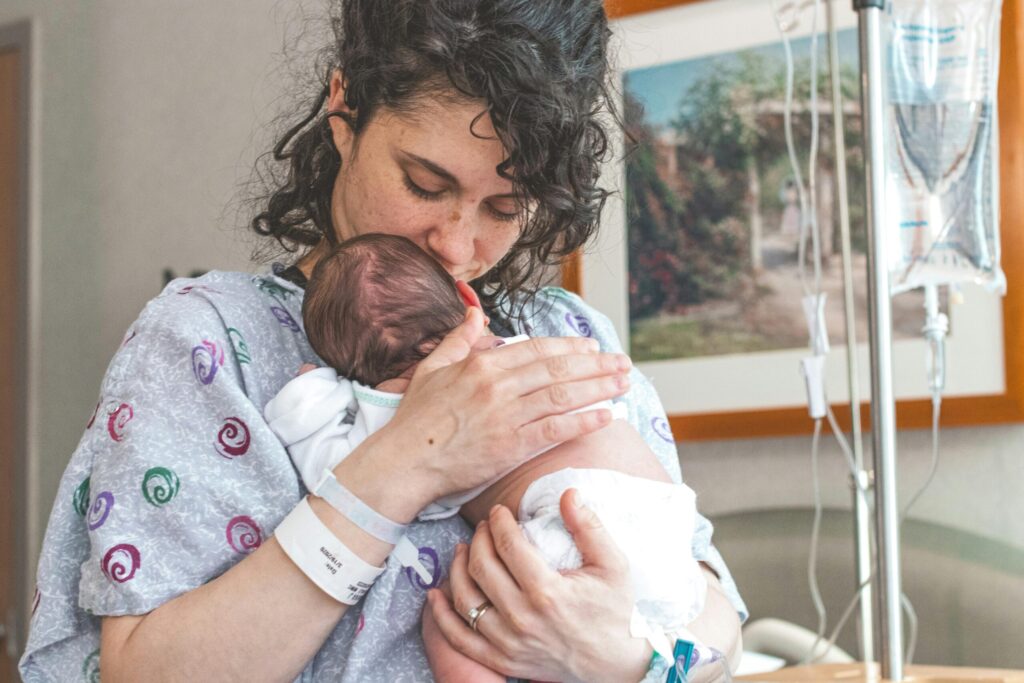As a mother of five and a midwife with over 20 years of experience, I’ve witnessed thousands of postpartum journeys. If there’s one thing I’ve learned, it’s that postpartum recovery looks different for everyone—but knowing what to expect can make all the difference in how you navigate this precious, challenging time.
Your body has just performed the miracle of bringing life into the world, and now begins another incredible journey: healing and adapting to life with your newborn. Let’s walk through this postpartum recovery timeline together, week by week, with the wisdom I’ve gathered both professionally and personally.
The First 24 Hours: The Beginning of Postpartum Recovery
The first day after delivery is intense, raw, and beautiful all at once. Your body is in rapid transition mode after birth.
Physical Changes
Your uterus begins contracting back to its pre-pregnancy size immediately. These contractions, called afterpains, may feel like mild labor contractions, especially when breastfeeding. I remember with my fifth baby, these pains were quite intense—nature’s way of efficiently shrinking the uterus after multiple pregnancies.
You’ll experience vaginal discharge called lochia—initially heavy and bright red, similar to a heavy period. Your nurses will monitor this carefully for any signs of excessive bleeding.
If you’ve had a vaginal delivery, perineal soreness is common. Ice packs and witch hazel pads become your best friends! For C-section mamas, the focus is on wound care and finding comfortable positions that don’t strain your incision.
Emotional Landscape
The “birth high” from hormones like oxytocin might carry you through these first hours, but don’t be surprised if you also feel overwhelmed or tearful. Your hormones are undergoing massive shifts, and you’re processing your birth experience while meeting your baby’s needs.
Week 1: Taking It One Day at a Time
This week is all about rest, bonding with your baby, and letting your body begin its healing process.
Physical Recovery Milestones
Your uterus continues contracting, shrinking to about the size of a grapefruit by week’s end. The heaviest bleeding typically begins to taper off, though you’ll continue to have lochia for several weeks.
Breast changes are significant as your milk comes in around day 2-5. Engorgement can be uncomfortable—I always recommend warm compresses before feeding and cool compresses after to ease discomfort.
For those with stitches, they’ll be at their most tender this week. Sitz baths three times daily work wonders for healing and comfort—a practice I’ve recommended to countless new mothers.
Navigating Emotional Waters
The notorious “baby blues” often appear around day three as hormone levels plummet. Up to 80% of new mothers experience this temporary emotional volatility. With my second baby, I remember crying because my husband brought the wrong flavor of Gatorade—then laughing at myself moments later!
Self-care Essentials
Rest whenever your baby sleeps—this isn’t just nice advice; it’s crucial for healing. Your body needs to recover from the equivalent of running a marathon.
Accept all offers of help with meals, household tasks, and baby care if you have older children. Create a simple “visitor policy” that protects your recovery time.
Stay hydrated and focus on nutrient-dense foods that support healing and milk production if you’re breastfeeding.
Week 2: Finding Your Rhythm in Postpartum Recovery
By now, the initial shock of new parenthood may be wearing off, but your body is still very much in healing mode.
Physical Healing Progress
Lochia typically transitions to a pinkish or brownish color and becomes lighter. Your uterus continues shrinking and may no longer be palpable above your pubic bone.
Hormone fluctuations continue, bringing night sweats and occasional emotional ups and downs. I remember waking up drenched during my postpartum periods—keeping a towel and change of clothes by the bed was a lifesaver!
C-section mamas should notice gradual improvement in pain levels, though the incision will still require gentle care.
Breastfeeding Adjustments
If you’re breastfeeding, this week often brings challenges as you and baby learn this dance together. Nipple soreness may peak before improving. Seeking help from a lactation consultant can make all the difference—even as a midwife, I benefited enormously from this support with my first baby.
Mental and Emotional Wellbeing
The baby blues should begin lifting by the end of this week. If intense sadness, anxiety, or intrusive thoughts persist or worsen, reach out to your healthcare provider about postpartum mood disorders, which affect up to 1 in 5 new mothers.
Weeks 3-4: Emerging from the Fourth Trimester Fog
These weeks often bring the first glimpses of a new normal, though your body still needs significant recovery time.
Physical Recovery Checkpoints
Bleeding usually decreases significantly but may fluctuate based on activity levels. Consider this your body’s built-in warning system—if bleeding increases, you’re likely doing too much.
Your uterus continues to shrink, approaching its pre-pregnancy size by week six.
Hormone levels are still adjusting, affecting everything from hair shedding to mood to libido—all perfectly normal parts of postpartum recovery.
Finding Your Footing as a Mother
Whether it’s your first baby or your fifth, each postpartum period requires adjusting to a new family dynamic. I found establishing simple routines helped ground me during these transitional weeks.
Nutrition for Healing
Your body needs approximately 500 calories more than pre-pregnancy if you’re breastfeeding. Focus on iron-rich foods to replenish stores after blood loss during delivery, and calcium-rich foods for bone health and milk production. A balanced diet with plenty of protein, healthy fats, and complex carbohydrates supports healing and energy levels.
Weeks 5-6: Approaching the Traditional Postpartum Milestone
The six-week mark is traditionally considered the end of the immediate postpartum period, though full recovery takes longer for many women.
Physical Recovery Progress
Most women experience significant reduction in physical discomfort by now. Lochia typically transitions to yellowish-white discharge before stopping altogether.
Your core and pelvic floor strength begin returning, though weakness and diastasis recti (separation of abdominal muscles) may persist.
If you had a C-section, your incision should be well-healed externally, though internal healing continues for months.
The Six-Week Checkup
This important appointment assesses your physical recovery and emotional wellbeing. Be honest about any concerns—whether physical symptoms, emotional struggles, or questions about contraception and intimacy.
Remember that the “all clear” for exercise and intimacy doesn’t mean you must resume these activities if you don’t feel ready. As I tell my midwifery clients, listen to your body first and foremost.
Gentle Return to Activity
If your provider approves, you might begin gentle exercises like pelvic floor strengthening and short walks. Rushing back to pre-pregnancy exercise routines can delay healing and increase complications.
Weeks 7-8: Expanding Your Horizons
As you approach the two-month mark, you may feel more confident venturing out more frequently with your baby.
Physical Recovery Continued
Most physical discomfort should be resolving, though some symptoms may persist:
- Lingering pelvic floor weakness, especially with previous births
- Hormonal effects like skin changes or night sweats
- Fatigue from interrupted sleep
Breastfeeding Evolution
If you’re breastfeeding, your supply typically regulates around this time, making engorgement less common and feedings more efficient.
Finding Your New Identity
The emotional journey of motherhood continues as you integrate your pre-baby identity with your role as this child’s mother. With each of my children, this process looked different—sometimes flowing easily, other times requiring intentional reflection.
Weeks 9-12: Closing the First Trimester of Parenthood
As you approach the three-month mark, many aspects of postpartum recovery feel more settled, though the journey continues.
Physical Healing Milestones
Most physical recovery is well-established, though some women continue experiencing:
- Hormonal hair loss (typically peaking around 3-4 months postpartum)
- Continued healing of diastasis recti
- Adjusting to menstrual cycles returning (timing varies widely, especially with breastfeeding)
Emotional Wellness Check
Check in with yourself about your emotional wellbeing. Postpartum mood disorders can develop or persist well beyond the early weeks. Organizations like Postpartum Support International provide resources if you’re struggling.
Sleep Patterns and Energy
While your baby’s sleep patterns continue evolving, finding ways to maximize your own rest remains important for complete recovery.
Beyond the First Three Months
Full postpartum recovery extends well beyond the traditional six-week or even three-month mark. Here’s what to remember:
The First Year
Your body continues healing and adjusting throughout your baby’s first year. Hormone levels, physical strength, and emotional wellbeing all progress at their own pace.
Be Patient With Yourself
The journey of physical and emotional recovery isn’t linear. Progress often comes with setbacks—this is normal and doesn’t reflect failure on your part.
Seek Support When Needed
As both a mother and midwife, I’ve learned there’s extraordinary strength in reaching out when you need help. Whether it’s physical symptoms that concern you, emotional struggles, or simply needing an extra hand, connecting with support systems benefits both you and your baby.
Conclusion: Your Unique Postpartum Recovery Journey
Every mother’s postpartum recovery timeline is uniquely her own. The week-by-week guide I’ve shared reflects common patterns, but your experience may vary based on your birth experience, previous pregnancies, support system, and individual health factors.
What matters most is approaching this time with patience, self-compassion, and awareness. The postpartum period isn’t just about “getting your body back”—it’s about honoring the transformation you’ve undergone and embracing the mother you’re becoming.
Remember, the world has gained a new person, but so have you—the new version of yourself that emerges through the transformative journey of birth and postpartum healing.



